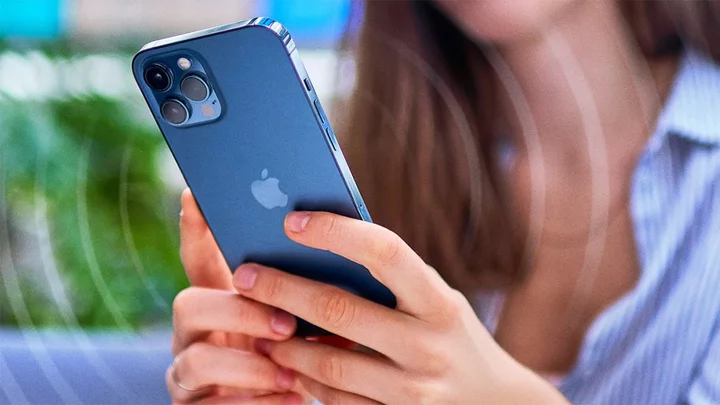You probably saw the headlines last week about how France, fearing the amount of "radiation" being emitted by the iPhone 12, banned the handset in the country and promised a total recall if Apple didn't fix it. Apple, in turn, said the 12 complies with all emissions rules in the world...but issued a software update anyway.
So what gives? Did something actually change in the way the iPhone 12 (or any other) operates and how much radiation it emits? Is your iPhone, or any other smartphone, irradiating you so badly that you can expect mutations to yourself and your progeny?
Thankfully, the answer to both of these questions is no. When we talk about smartphone radiation, we're not talking about the same kind of radiation that one could be exposed to by handling uranium rods at the nuclear power plant. Here's why you shouldn't be too worried:
The Different Kinds of Radiation
The basic definition of "radiation" is a transmission of energy, be it in the form of particles or waves, traveling fast—the speed of light fast. It's a term used for a lot of different things that radiate, from gravitational waves to sound (acoustic radiation) to everything on the electromagnetic spectrum (radio, microwaves, infrared, x-rays, gamma rays, etc.). That last one is where the radiation from a phone comes into play.
Radioactivity—aka "radioactive decay" or the really scary sounding "radioactive disintegration"—isn't a given with all types of radiation. It comes only from the type of spontaneous radiation that happens when the source has decaying nuclei (aka, a lot of atoms each with a nucleus spewing electrons).
Radio waves and microwaves aren't radioactive.
Another term for them is non-ionizing. Radio waves and microwaves—typically lumped together as "radio frequency" or RF radiation—can go through things. When they do, there's little, if any, impact on what they pass through. That includes living human tissue. RF is measured from 3 kilohertz (kHz) all the way up to 300 gigahertz (GHz); over 1 GHz, you're in microwave territory, above 30GHz you're in millimeter wave (MMW)—frequencies used by 5G wireless networks.
Ionizing radiation—the kind you do get from electromagnetic radiation like x-rays and gamma rays—can be dangerous, though. It may not be on the level of dangerous as "radioactive" but ionizing radiation can harm tissue it passes through. That's why you typically have to wear a heavy, lead-lined apron during most medical x-ray scans. At high enough levels, ionizing radiation can even be detected with a Geiger counter.
But that's not what's coming out of your smartphone. The electromagnetic radiation traveling to and from our mobile devices is non-ionizing, non-radioactive radio waves.
So why did French authorities issue a recall on the iPhone 12, then?
Simply put, too much of anything—like, say, radio waves in a dense concentration at one localized point—could be bad. Because it turns out non-ionizing radiation can do something we all know well from owning microwave ovens: It can heat up water (and we humans are mostly water).
There's even a group called the International Commission on Non-Ionizing Radiation Protection (ICNIRP) which says prolonged exposure to it can cause burns or heat stroke. That's why it's not unreasonable that government institutions would want to set some limits even on something billions of us use every day with few reported ill effects.
How RF Radiation is Measured
Saying a set of radio waves falls in a certain area of the electromagnetic spectrum is one thing, but for safety, we need to know how it impacts the human body. To do that, tests are run constantly to see how much radiation energy—that is, heat generated by the radiation source, in this case, a smartphone—is absorbed in tissue.
The measurement to check this is called Specific Absorption Rate (SAR). The maximum SAR amount recognized by almost all countries is 2 to 4 watts per kilogram (aka 2w/kg)—the ICNIRP sets global guidelines. A dosage over 4w/kg from a cellphone is at the beginning of dangerous. The limit in the European Union is 4w/kg. In the United States, the Federal Communications Commission's limit SAR level of 1.6 watts per kilogram (1.6 W/kg) from a cellular phone held up to the ear/head.
That body part is critical, as SAR limits fluctuate depending on where the phone is. France's proclamation against the iPhone 12 was based on a body SAR of 5.74w/kg—which is a lot more than 4, which is already a level below which most harm would occur.
Also, that test was also conducted when the handset "was being held in the hand or kept in a trouser pocket" according to Reuters. iPhone 12 passed the SAR measurement when it was in a jacket pocket—and when held up to a head.
By the way, the 1.6w/kg SAR limit from the FCC? That was set sometime in the mid-1990s, long before the smartphone we know today was even conceived. The ICNIRP's guidelines are a full 10x below levels found to cause actual damage.
Radiation Is Tricky to Test
There's some controversy about how SAR is measured in the first place. There's not an easy way to directly measure/observe what prolonged exposure to smartphone radiation does to the human body, because doing so would require measurements from inside the body itself (namely the skull), which isn't exactly ideal. So instead of direct measurements, scientists typically use indirect, approximated ones.
Standard SAR lab tests involve "a liquid-filled mold simulating a human head and body with brain and muscle tissue." Tests are done with RF devices five millimeters away from the simulating liquid, and run at full power for six minutes.
The US knows this liquid-filled fake human head/body test does not reflect actual cellphone use and it's not a secret. Others say the same. The Environmental Health Trust, for example, says the SAR test is inadequate, citing the use patterns, using averaged numbers, and that the tests have a 30% margin of error. But it also claims SAR limits of 1.6W/kg are too lenient. It's mission is to safeguard human health after all, not be an apologist for cell phone over-use.
So…Are Smartphones Dangerous or Not?
Overall, probably not.
Most SAR limits are already set very low, so even exceeding them—as the iPhone 12 did in France this year, and as the iPhone 11 was found to do in early 2020, and as the iPhones 7 and 8 did for a while—doesn't put real humans in much danger of a tissue heat-up caused by excessive SAR.
In 2011, the World Health Organization's International Agency for Research on Cancer (IARC) actually classified RF radiation as a "possible carcinogen" to humans. It's happened in some lab rats—male mice in particular. But "possible" is a long way from probable, just as probable is a long way from "carcinogenic." As noted by iNews.co.uk, "This [classification] is supposed to express uncertainty and spur scientists on to do better and more comprehensive studies, but in practice it just produces health fears." After all, other "possible" carcinogens from the IARC include aspartame, aloe vera extract, and pickled vegetables.
Staying Safe
While the science suggests that smartphone radiation doesn't present a huge risk to human health, if you're still worried about the effect of RF radiation on your body from your iPhone or any other smartphone, you can take certain steps to further reduce the potential for harm.
Arguably the easiest method is to simply hold the handset away from your head when speaking. Better yet, use the speaker phone or wired headphones so the RF source (the phone) isn't close at all.
You can also get a little mobile Faraday pouch for your bag that blocks RF signals too (but don't expect to get any calls). And wait to make calls until you have a lot of bars, so the phone isn't pushing too hard to get a signal.
Beyond that, you can also look for a low RF phone via the FCC's ID Search form, or try the SAR Search of 3,943 devices from the Bundesamt für Strahlenschutz (Federal Office for Radiation Protection) in Germany.
For more steps you can take, visit the Healthy Tech at Home Project (part of the Environmental Health Trust) to read Simple Steps to Reduce Radiation.









